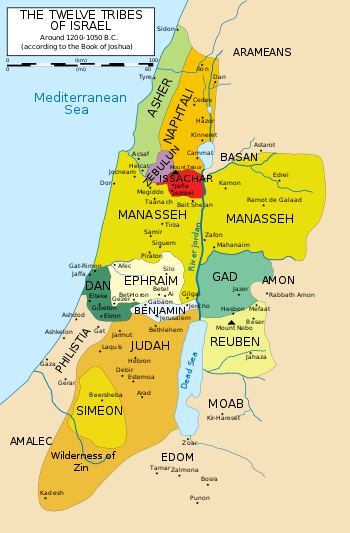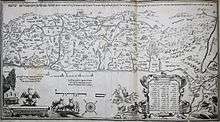Twelve Tribes of Israel

According to the Hebrew Bible, the Twelve Tribes of Israel or Tribes of Israel (Hebrew: שבטי ישראל) descended from the 12 sons of the patriarch Jacob (who was later named Israel) by two wives, Leah and Rachel, and two concubines, Zilpah and Bilhah.
Tribes
| Tribes of Israel |
|---|
 |
| The Tribes |
| Related topics |
Deuteronomy 33:6–25 and Judges 5:14–18 present parallel listings of the twelve tribes:
- Reuben
- Simeon
- Levi
- Judah
- Issachar
- Zebulun
- Dan
- Naphtali
- Gad
- Asher
- Joseph (later Ephraim and Manasseh)
- Benjamin
Jacob elevated the descendants of Ephraim and Manasseh (the two sons of Joseph and his Egyptian wife Asenath)[1] to the status of full tribes in their own right, replacing the tribe of Joseph.[2]
In the Bible's version of events, the period from the conquest of Canaan under the leadership of Joshua until the formation of the first Kingdom of Israel, passed with the tribes forming a loose confederation, described in the Book of Judges. Modern scholarship has called into question the beginning, middle, and end of this picture[3][4] and the account of the conquest under Joshua has largely been abandoned.[5][6][7] The Bible's depiction of the 'period of the Judges' is widely considered doubtful.[3][8][9] The extent to which a united Kingdom of Israel ever existed is also a matter of ongoing dispute.[10][11][12]
Living in exile in the sixth century BCE, the prophet Ezekiel has a vision for the restoration of Israel,[13] of a future utopia in which the twelve tribes of Israel are living in their land again.[14]
In Christianity
In the Christian New Testament, the twelve tribes of Israel are referred to twice in the gospels and twice in the Book of Revelation. In Matthew, paralleled by Luke, Jesus anticipates that in the Kingdom of God, his followers will "sit on [twelve] thrones, judging the twelve tribes of Israel".[15][16] In the vision of the writer of the Book of Revelation, 144,000 of all the tribes of the children of Israel were "sealed", 12,000 from each tribe[17] and in his vision of the New or Heavenly Jerusalem, the tribes' names were written on the city gates:
The names of the twelve tribes of the children of Israel: three gates on the east, three gates on the north, three gates on the south, and three gates on the west.[18]
Coat of arms
Thesouro de Nobreza, 1675
 Asher
Asher Benjamin
Benjamin Dan
Dan Ephraim
Ephraim Gad
Gad Issachar
Issachar Judah
Judah Manasseh
Manasseh Naphtali
Naphtali Reuben
Reuben Simeon
Simeon Zebulun
Zebulun
See also
References
- ↑ Genesis 41:50
- ↑ Genesis 48:5
- 1 2 "In any case, it is now widely agreed that the so-called 'patriarchal/ancestral period' is a later 'literary' construct, not a period in the actual history of the ancient world. The same is the case for the ‘exodus’ and the 'wilderness period,' and more and more widely for the 'period of the Judges.'" Paula M. McNutt (1 January 1999). Reconstructing the Society of Ancient Israel. Westminster John Knox Press. p. 42. ISBN 978-0-664-22265-9.
- ↑ Alan T. Levenson (16 August 2011). The Making of the Modern Jewish Bible: How Scholars in Germany, Israel, and America Transformed an Ancient Text. Rowman & Littlefield Publishers. p. 202. ISBN 978-1-4422-0518-5.
- ↑ "Besides the rejection of the Albrightian ‘conquest' model, the general consensus among OT scholars is that the Book of Joshua has no value in the historical reconstruction. They see the book as an ideological retrojection from a later period — either as early as the reign of Josiah or as late as the Hasmonean period." K. Lawson Younger Jr. (1 October 2004). "Early Israel in Recent Biblical Scholarship". In David W. Baker; Bill T. Arnold. The Face of Old Testament Studies: A Survey of Contemporary Approaches. Baker Academic. p. 200. ISBN 978-0-8010-2871-7.
- ↑ "It behooves us to ask, in spite of the fact that the overwhelming consensus of modern scholarship is that Joshua is a pious fiction composed by the deuteronomistic school, how does and how has the Jewish community dealt with these foundational narratives, saturated as they are with acts of violence against others?" Carl S. Ehrlich (1999). "Joshua, Judaism and Genocide". Jewish Studies at the Turn of the Twentieth Century, Volume 1: Biblical, Rabbinical, and Medieval Studies. BRILL. p. 117. ISBN 90-04-11554-4.
- ↑ "Recent decades, for example, have seen a remarkable reevaluation of evidence concerning the conquest of the land of Canaan by Joshua. As more sites have been excavated, there has been a growing consensus that the main story of Joshua, that of a speedy and complete conquest (e.g. Josh. 11.23: 'Thus Joshua conquered the whole country, just as the LORD had promised Moses') is contradicted by the archaeological record, though there are indications of some destruction and conquest at the appropriate time. Adele Berlin; Marc Zvi Brettler (17 October 2014). The Jewish Study Bible (Second ed.). Oxford University Press. p. 951. ISBN 978-0-19-939387-9.
- ↑ "The biblical text does not shed light on the history of the highlands in the early Iron I. The conquest and part of the period of the judges narratives should be seen, first and foremost, as a Deuteronomist construct that used myths, tales, and etiological traditions in order to convey the theology and territorial ideology of the late monarchic author(s) (e.g., Nelson 1981; Van Seters 1990; Finkelstein and Silberman 2001, 72-79, Römer 2007, 83-90)." Israel Finkelstein (2013). The Forgotten Kingdom: The Archaeology and History of Northern Israel (PDF). Society of Biblical Literature. p. 24. ISBN 978-1-58983-912-0.
- ↑ "In short, the so-called ‘period of the judges’ was probably the creation of a person or persons known as the deuteronomistic historian."J. Clinton McCann (2002). Judges. Westminster John Knox Press. p. 5. ISBN 978-0-8042-3107-7.
- ↑ "Although most scholars accept the historicity of the united monarchy (although not in the scale and form described in the Bible; see Dever 1996; Na'aman 1996; Fritz 1996, and bibliography there), its existence has been questioned by other scholars (see Whitelam 1996b; see also Grabbe 1997, and bibliography there). The scenario described below suggests that some important changes did take place at the time." Avraham Faust (1 April 2016). Israel's Ethnogenesis: Settlement, Interaction, Expansion and Resistance. Routledge. p. 172. ISBN 978-1-134-94215-2.
- ↑ "In some sense most scholars today agree on a 'minimalist' point of view in this regard. It does not seem reasonable any longer to claim that the united monarchy ruled over most of Palestine and Syria." Gunnar Lebmann (2003). Andrew G. Vaughn; Ann E. Killebrew, eds. Jerusalem in Bible and Archaeology: The First Temple Period. Society of Biblical Lit. p. 156. ISBN 978-1-58983-066-0.
- ↑ "There seems to be a consensus that the power and size of the kingdom of Solomon, if it ever existed, has been hugely exaggerated." Philip R. Davies (18 December 2014). "Why do we Know about Amos?". In Diana Vikander Edelman; Ehud Ben Zvi. The Production of Prophecy: Constructing Prophecy and Prophets in Yehud. Routledge. p. 71. ISBN 978-1-317-49031-9.
- ↑ Ezekiel 47:13
- ↑ Michael Chyutin (1 January 2006). Architecture and Utopia in the Temple Era. A&C Black. p. 170. ISBN 978-0-567-03054-2.
- ↑ Matthew 19:28
- ↑ Luke 22:30
- ↑ Revelation 7:1-8
- ↑ Revelation 21:12-13
External links
| Wikimedia Commons has media related to Twelve Tribes of Israel. |